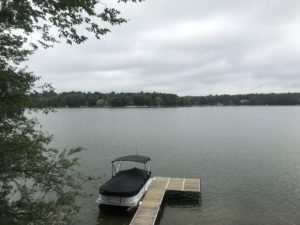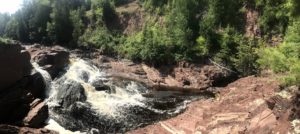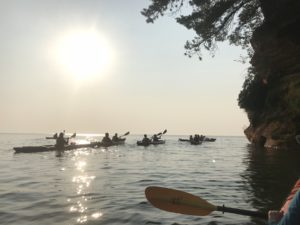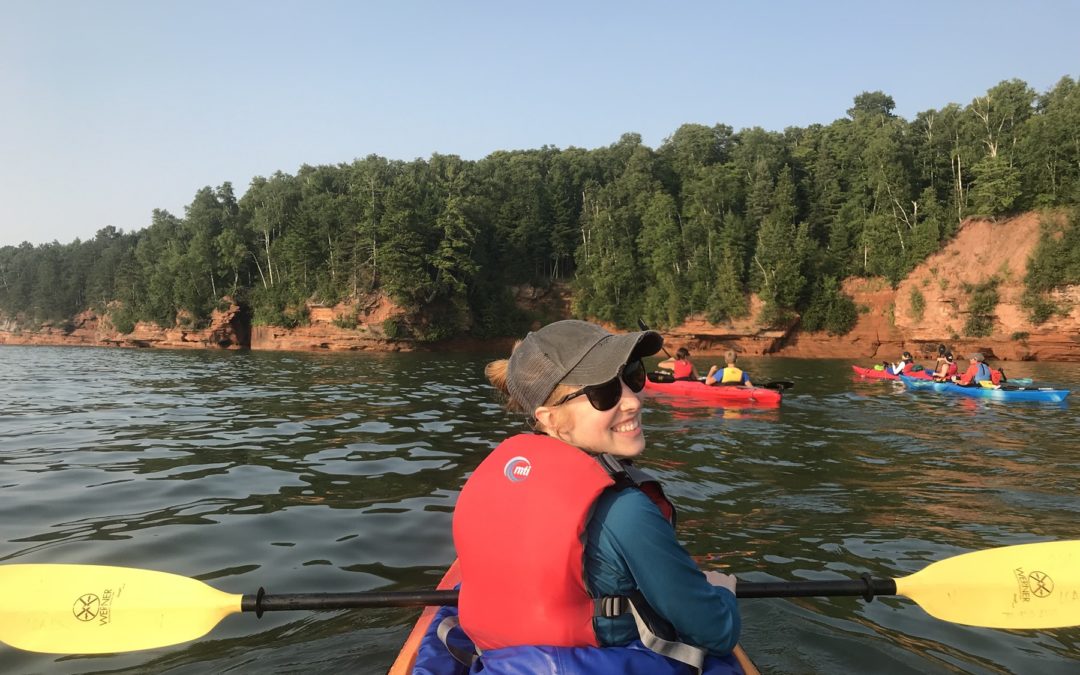Well, the trip has finally begun! 4+ years of the two of us saving and the generosity of family and friends from our wedding together have made this trip happen, and we are so grateful. While we were excited to get to some different regions of the country we have not spent time in, we didn’t want to skip our beloved “U.P.” of Michigan and Great Lakes.
After deliberating about the packing of our car for hours, double-triple-quadruple checking lists and to-dos, we left our house in Kalamazoo and headed straight to – the library! We renewed our library accounts to allow us to get lots of audio books made available to us to accompany long hours in the car. Right away we were taught a lesson in opportunistic experiences, and not to be to rigid in sticking to a schedule. We ran into some family members who were enjoying a cocktail in downtown Kalamazoo, who heckled us from the street and generously offered to buy us a drink. We did not refuse!
An initial 3-hour leg of driving up US-131 headed north took us to the cottage of my aunt and uncle on beautiful Rennie Lake near Traverse City. The night ran late with much needed “catchup” with cousins, and the excitement and discussion of experiences to come.


Our first major destination was Apostle Islands National Lakeshore in Wisconsin, but the Ottawa National Forest in the western U.P. was a great halfway point. Our campground was on Golden Lake, and we had the place nearly to ourselves. The forest around our campsite was lush; filled with ferns and familiar Michigan trees. A rumbling and snorting generator three campsites down (running so that the trailer’s owner could watch a DVD) brought us back down to earth and brought up an interesting observation: When you camp or seek the outdoors they are looking to leave the “civilized” world behind, to escape to a more simple nature. The degree to which you accept that simplicity and sacrifice your luxuries is up to you.



The next mild morning we sat alongside the lake and appreciated it’s tranquility before we realized we were not alone; a bald eagle was perched in a leggy paper birch growing 30 feet down the shoreline. With that surefire sign that we were in a wild place, we packed up and headed further north and west. Given that sheer number of hours we will be in the car, we are beginning to prioritize actually making a stop to sit down and eat a decent lunch. This lunch stop took place at the border between Michigan and Wisconsin on that day: the Montreal River and Superior Falls. This river is what gives Michigan’s upper peninsula it’s squiggly western border, and tumbles over exposed bedrock before flowing into Lake Superior. The site is actually managed by a hydropower company, but there is easily accessible trails and parking for the public to appreciate this unique spot. Down along the shoreline, heaps of huge driftwood chunks serve as a backdrop, 40 feet back from the shoreline. There were rows of natural materials that look like they have been arranged by a fastidious rock picker running parallel to the shoreline. Gravel and sand together in bands are separated by small boulders and rows of jagged branches and trees. Rows correspond to the intensity of the Lake Superior wave action. Small strips of gravel and sand show past low intensity wave action, and large stones and trees from more intense wave action. On that calm day, it was a visual reminder of the raw power that Lake Superior can have.


![]()



 By the time we reached Bayfield, Wisconsin it was early evening. The city, although not located in the Apostle Islands Lakeshore itself are a launching off point for visitors, and home the the National Park Service visitor’s center. The center was housed in a beautiful historic building: an old courthouse that was surely there when the town was founded. Taking a shot at a large campground in the park boundaries, we shuddered at the site of an RV zoo with mowed grass and a lack of trees. We moved on for a more basic and quiet site – and we got it! A series of pothole ridden dirt roads led us to the Point Dutour campgrounds on the Red Cliff Indian Reservation, sharing it’s natural border with the park service to the west. We took a day to recoup, enjoy the forested area surrounding our site, went for a huffy trail run, and a brisk swim in Lake Superior. We had views of several distant islands, as well as through kayakers and sailboats, and gave us a sensory impression of life on the shoreline there.
By the time we reached Bayfield, Wisconsin it was early evening. The city, although not located in the Apostle Islands Lakeshore itself are a launching off point for visitors, and home the the National Park Service visitor’s center. The center was housed in a beautiful historic building: an old courthouse that was surely there when the town was founded. Taking a shot at a large campground in the park boundaries, we shuddered at the site of an RV zoo with mowed grass and a lack of trees. We moved on for a more basic and quiet site – and we got it! A series of pothole ridden dirt roads led us to the Point Dutour campgrounds on the Red Cliff Indian Reservation, sharing it’s natural border with the park service to the west. We took a day to recoup, enjoy the forested area surrounding our site, went for a huffy trail run, and a brisk swim in Lake Superior. We had views of several distant islands, as well as through kayakers and sailboats, and gave us a sensory impression of life on the shoreline there.



That evening, we sprung for a guided sea kayak trip to gain an even better impression of the shoreline. Lost Creek Adventures is located in nearby Cornucopia, and seemed to be humming with the activity of visiting “down-staters,” all wanting to see the national lakeshore on it’s most illuminating side: from the water. Our guides were very professional and brimming with youthful enthusiasm, silly ice breaker jokes, and as committed to their professions as anyone. They took us through use of the kayaks, spray skirts, rudders, and paddles. These sea kayaks were a slightly different beast from the basic kayaks Emily and I were more familiar with that we use on calmer inland lakes. Everyone was paired up in double kayaks, the steering done from the rear position with foot pedals that moved the rudder. I thought walking and chewing gum was a challenge, there was a good dose of coordination needed here! We quickly gained a rhythm, coordinating our paddle strokes, and steering to stay in a loose “pod” of kayakers. Getting closer to the rocky shoreline as the sun was getting lower in the sky was like turning up the saturation on a computer screen. The warm tans, oranges, reds, and browns adorned the gritty sandstone bluffs, with white pines, paper birches, and white cedar trees towering from the top looking down on us. We stopped along the way for quick doses of natural history education ranging from the local geography of the 22 islands, geological history, and research happening in the park. What’s more, we were encouraged to interact with the rocky shoreline when safe to do so. We were led through a series of low arches, stone channels, and rocky bends that tested our maneuverability and claustrophobia! Heading back to the shoreline for a hearty crossfit-like session of carrying kayaks up wooden stairs, the group had shown what a couple hours of practice could do: coordinated paddle strokes splashed the cold water and jovial conversations buzzed around as our group sliced through the calm evening water. Worth every penny.






